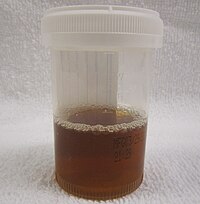
Photo from wikipedia
RATIONALE AND OBJECTIVES This paper describes an ongoing investigation of imaging and characterization of ischemia-reperfusion (IR) and investigated the use of color-coded digital subtraction angiography (DSA) to assess reperfusion injury… Click to show full abstract
RATIONALE AND OBJECTIVES This paper describes an ongoing investigation of imaging and characterization of ischemia-reperfusion (IR) and investigated the use of color-coded digital subtraction angiography (DSA) to assess reperfusion injury or potential injury. METHODS New Zealand white rabbits were subjected to right hindlimb ischemia (IR, n = 24) or sham operation (control, n = 6). After 3 hours, the IR rabbits underwent reperfusion and were assessed at 0, 6, 12, or 24 hours (n = 6 each). DSA of the bilateral vastus lateralis muscle of each animal was performed. The maximum contrast enhancement value of a consistent region of interest in the right and left hind limbs (peak enhancement-R/L) was determined. Associations between the relative ratio of the peak right limb to the peak left limb (peak-R/L) and the following blood indicators of IR injury were analyzed: lactic dehydrogenase (LDH), creatine kinase (CK), malondialdehyde (MDA), and superoxide dismutase (SOD). RESULTS Serum LDH, CK, and MDA values in each IR group were significantly higher than those of the control group and were positively associated with the IR interval, whereas SOD was significantly lower and negatively associated. The mean peak-R/L decreased linearly with the IR interval from 1.07 ± 0.01 in the control group, and 0.93 ± 0.06, 0.79 ± 0.05, 0.65 ± 0.04, and 0.47 ± 0.04 at 0, 6, 12, and 24 hours in the IR groups. The coefficients of correlation between the peak-R/L and LDH, CK, MDA, SOD serum levels were -0.885, -0.908, -0.541, and 0.832, respectively. CONCLUSIONS Color-coded DSA may be used for monitoring the dynamics of skeletal muscle IR injury.
Journal Title: Academic radiology
Year Published: 2018
Link to full text (if available)
Share on Social Media: Sign Up to like & get
recommendations!